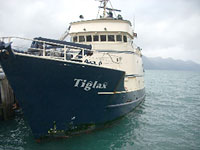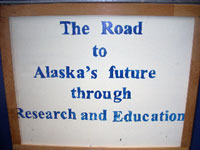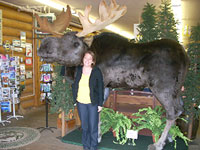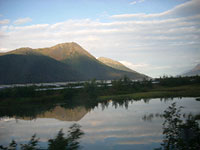

 | |||||||||||||
|
|
Journals 2009/2010Jennifer Duncan
September 10, 2009 It was 5:15 a.m. when I rolled over to hit the snooze button. The day finally arrived to start my adventure to Alaska. It has been almost 10 years since I have been in the science field and worked as a scientist, exploring our oceans. The idea of participating in a current marine research project with scientists once again is rejuvenating. The yellow taxi cab picked me up as I kiss my adorable, eleven-month old baby boy, Carter and supportive husband, Marc, goodbye. He understands my passion to explore the oceans and to educate people about it. I currently teach at Madeira Beach Fundamental Middle School, a marine theme school that is located on the diverse and plentiful, Boca Ciega Bay in St. Petersburg, Florida. We have multiple aquariums including touch tanks, display tanks, and personal aquariums for the students to run. Our weekly field trips take place in our backyard collecting marine organisms from the docks, mangrove trail, and our beach. Oceanographic scientific information can be complicated yet imperative for our students and population to understand. We are all affected by what happens in our oceans, we are all connected. If one small factor is altered in our ecosystem it affects all of us. I am honored to have be chosen as one of the few applicants to be accepted into the National Science Foundation's, ARMADA Project. This project is well thought-out and systematically directed by the Office of Marine Programs at the University of Rhode Island. The ARMADA project methodically placed me aboard the research vessel, R/V Tiglax based out of Seward Alaska. The R/V Tiglax is owned and operated by the U.S. Fish and Wildlife Service of the Department of the interior. Dr. Jeremy Mathis from the University of Alaska Fairbanks, Institute of Marine Science will be the chief scientist. This research is funded by the North Pacific Research Board, a non-governmental organization (NGO) of the 2005-2009 and represents a continuation of the 1998-2004 NE Pacific GLOBEC program.
The cruise will analyze an imaginary line in the Gulf of Alaska, known as the Seward line with 13 stations to study. This line goes out 130 miles out to sea covering the continental shelf, slope, and the deep water basin. The furthest station out is the Gulf of Alaska (GAK) 13 and is approximately 1800 meters (5,905 feet) deep. This was our second station we traveled to before the storm hit. The main purpose of this cruise is to develop an understanding of the response of marine waters to climate variability. It will be interesting to see the changes that have gone on in the past; this is the 13th consecutive year of this long-term observation program. Ocean acidification has been one of the most significant studies Dr. Jeremy Mathis and his graduate students have been focusing on. However, there are several other studies being conducted. Some of the data that is included but not limited to; determining primary production, phytoplankton biomass and distribution, zooplankton abundance, copepod rates of somatic growth and egg production, thermocline, halocline, Dissolved Organic/Inorganic Carbon (DOC, DIC) and nutrient (nitrogen, phosphorus) levels in the waters of the Gulf of Alaska. Questions for students: |
||||||||||||



